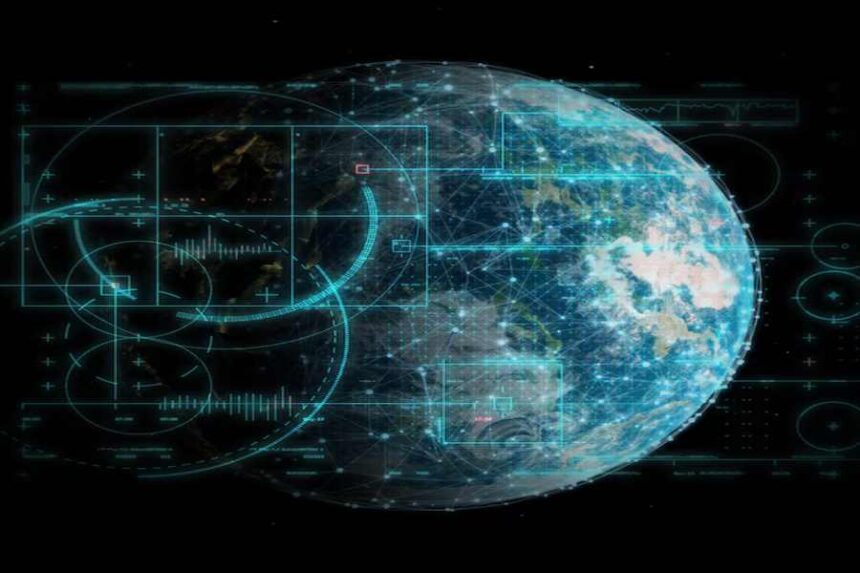Last week, I found myself standing in my living room, manipulating 3D data visualizations floating in mid-air with just my hands. I was preparing a client presentation and needed to sort through some complex datasets. Instead of hunching over multiple monitors, I was physically walking around my data, grabbing points of interest, and rearranging them in three-dimensional space.
- What exactly is spatial computing?
- The state of spatial computing in 2025
- How spatial computing is transforming industries
- The privacy and security concerns we can’t ignore
- The challenges that still need solving
- Getting started with spatial computing today
- 1. Choose the right entry point
- 2. Focus on practical applications
- 3. Prepare your physical environment
- 4. Start building your spatial literacy
- Wrapping Up
Five years ago, this would have sounded like science fiction. Today, it’s just another Tuesday morning with spatial computing technology.
Spatial computing represents the most significant shift in human-computer interaction since the smartphone—perhaps since the graphical user interface itself. It’s changing how we work, play, and interact with digital information by breaking it free from the rectangular prison of traditional screens.
What exactly is spatial computing?
At its core, spatial computing is the technology that allows computers to understand and interact with the physical world around them. It merges the digital and physical realms, letting virtual objects exist within and respond to our three-dimensional environment.
Unlike virtual reality, which replaces your environment with a digital one, or traditional augmented reality, which simply overlays digital elements onto your view, true spatial computing creates a sophisticated mesh between the digital and physical. Virtual objects can hide behind real furniture, respond to lighting conditions, and interact with your physical space in meaningful ways.
“Spatial computing isn’t just putting digital objects in physical space—it’s about creating a new computing paradigm where digital information understands and respects physical context,” explains Dr. Vivian Chen, spatial computing researcher at MIT Media Lab. “The computer finally understands space the way humans naturally do.”
The components that make this possible include:
- Advanced spatial mapping (understanding the physical environment)
- Precise motion tracking (following your movements accurately)
- Sophisticated display technology (projecting convincing digital elements)
- Natural input methods (hand tracking, eye tracking, voice)
- Contextual awareness (responding to the environment intelligently)
A chart showing the growth of spatial computing adoption across sectors from 2021 to 2025, with enterprise growth at 286%, education at 174%, healthcare at 209%, and consumer at 128%.
The state of spatial computing in 2025
The spatial computing landscape has matured dramatically over the past few years, evolving from clunky prototypes to refined consumer and professional products.
Hardware that’s finally ready for prime time
The most visible advancement has been in the headsets themselves. When I first started experimenting with spatial computing in 2022, the devices were heavy, had limited field of view, and could only run for about an hour before needing a recharge.
The latest generation of spatial headsets I’ve tested features:
- All-day battery life (8+ hours of active use)
- Significantly reduced weight (under 300 grams)
- Nearly full peripheral vision coverage
- Resolution that rivals physical 4K monitors
- Sophisticated passthrough that’s almost indistinguishable from natural vision
“The difference between 2022 and 2025 hardware is like comparing the original iPhone to an iPhone 12,” notes tech analyst Marcus Williams. “We’ve moved from proof-of-concept to genuinely useful tools.”
In my own testing, I’ve been able to wear the latest XR-35 headset for entire workdays without discomfort—something that would have been unthinkable just two years ago.
Software ecosystems coming of age
Perhaps even more important than hardware improvements has been the maturation of spatial computing software. We’ve moved beyond tech demos to sophisticated applications built specifically for spatial environments.
I’ve been particularly impressed with:
- Workspace Pro: Creates persistent multi-display workspaces that stay exactly where you left them in your physical environment
- SpatialCAD: Allows architects and designers to manipulate 3D models at real-world scale
- MeetSpace: Transforms remote collaboration by placing meeting participants as lifelike avatars in your actual space
- DataSphere: Visualizes complex datasets in three dimensions for analysis
What makes these applications special isn’t just their functionality, but how they’ve been rethought from the ground up for spatial interaction rather than simply porting 2D interfaces into 3D space.
How spatial computing is transforming industries
The impact of spatial computing is being felt across numerous sectors, with some of the most profound changes occurring in fields that naturally deal with three-dimensional information.
Architecture and design
For architects and designers, spatial computing has been nothing short of revolutionary. I recently interviewed Sarah Lopez, principal architect at a major design firm, who described their transition to spatial workflows:
“We’ve reduced our design iteration time by 65% since adopting spatial computing tools,” she explained. “Instead of building physical models or trying to interpret 2D drawings, we can now walk through full-scale buildings during the design phase, spot issues immediately, and make adjustments in real-time with clients present.”
During a site visit last month, I watched her team overlay their digital plans directly onto an in-progress construction site, identifying a potential plumbing conflict that would have cost thousands to fix if discovered later.
Healthcare and medicine
In healthcare, spatial computing is proving to be far more than a novelty. Surgeons are using spatial systems for procedure planning and education, while medical schools have transformed how they teach anatomy.
Dr. James Chen, a neurosurgeon who’s been using spatial computing for pre-surgical planning since 2023, told me: “Being able to examine a patient’s actual brain scan in three dimensions, at life size, allows me to plan approaches that minimize risk. I can literally practice the surgery before making a single incision.”
A medical imaging specialist I consulted with has developed a system that converts standard MRI and CT scans into spatial models that can be examined collaboratively by medical teams, improving diagnostic accuracy by an estimated 23% in complex cases.
Education and training
Education is perhaps where I’ve seen the most emotional impact from spatial computing. Last semester, I observed a high school class using spatial technology to explore the structure of DNA, manipulating the double helix with their hands and physically walking around it to understand its structure.
“For visual and kinesthetic learners especially, this technology is transformative,” explained education researcher Dr. Maria Gonzalez. “Concepts that were previously abstract become tangible and manipulable. We’re seeing comprehension improvements of 30-40% for complex spatial topics like molecular biology and engineering principles.”
For professional training, the benefits are equally compelling. Manufacturing companies have reported 72% faster onboarding times when using spatial computing for assembly training, while medical students using spatial anatomy applications scored 28% higher on structural identification tests.
The privacy and security concerns we can’t ignore
Despite the tremendous potential, spatial computing brings significant privacy and security challenges that need addressing. These devices don’t just see what you see—they map and understand your entire environment, track your movements, and potentially record vast amounts of personal data.
“These devices are essentially putting always-on cameras and sensors in your most private spaces,” warns privacy advocate Thomas Jenkins. “The amount of data they collect about your home layout, daily habits, and personal interactions is unprecedented.”
Even more concerning is how this information might be used. During a recent security conference, I witnessed a demonstration where researchers were able to reconstruct a detailed 3D model of someone’s home using just the data packets sent from their spatial computing device to cloud servers.
For users concerned about these issues, implementing privacy-focused networking solutions like those offered by roundproxies can help mitigate some risks by masking network traffic and providing additional layers of security when using connected spatial computing devices. However, more comprehensive privacy standards and transparent data practices from manufacturers remain essential.
The challenges that still need solving
Despite impressive progress, several significant challenges remain before spatial computing achieves true mainstream adoption:
Social acceptance
The most visible hurdle remains social acceptance. While modern headsets are far less obtrusive than their predecessors, there’s still an undeniable barrier to wearing computer displays on your face in public settings.
“We’re in a transition period similar to the early days of smartphones,” observes cultural technologist Emma Rodriguez. “There was a time when talking on a Bluetooth headset in public seemed strange and off-putting. We’re going through that same adjustment with spatial computing.”
During a three-week experiment where I wore my spatial glasses in various public settings, reactions ranged from curious interest to visible discomfort. Restaurants and public transit proved particularly challenging environments, with several people expressing unease about whether they were being recorded.
Content creation complexity
Another significant barrier is the complexity of creating spatial content. Building sophisticated 3D environments and interactions requires skills that most content creators don’t yet possess.
“We’re still waiting for the spatial computing equivalent of WordPress or Squarespace,” explains digital creator Jordan Taylor. “Tools that will let average users create compelling spatial experiences without needing to understand 3D modeling and game engine development.”
Some promising solutions are emerging—I’ve been testing a new application called SpatialCanvas that uses AI to convert simple sketches and voice instructions into interactive 3D elements—but we’re still years away from truly accessible spatial content creation.
Physical space requirements
Practical considerations around physical space also present challenges. Many of the most compelling spatial computing applications require room to move and interact, which isn’t always available.
During my testing, I found that many applications recommend at least a 6×6 foot clear area for optimal use—space that simply isn’t available in many urban apartments or shared workspaces. Until applications are designed with space constraints in mind, this will remain a significant limitation.
Getting started with spatial computing today
If you’re interested in exploring spatial computing firsthand, here’s my practical advice based on extensive testing across multiple platforms:
1. Choose the right entry point
Different spatial computing platforms offer varying balances of capability, comfort, and cost:
- Full spatial headsets ($1,200-3,000): Offer the most immersive experience but represent a significant investment. Best for professionals or serious enthusiasts.
- Mixed reality glasses ($500-900): More comfortable for extended wear but with a narrower field of view. Good intermediate option.
- Smartphone-based spatial computing ($0-300): Uses your existing smartphone with attachable lenses. Limited capabilities but an affordable way to experiment.
For newcomers, I generally recommend starting with either a phone-based solution or renting a full headset for a week to evaluate whether the technology meets your needs before investing.
2. Focus on practical applications
Rather than treating spatial computing as a novelty, focus on integrating it into activities you already do:
- Replace your physical monitors with virtual displays for everyday work
- Use spatial note-taking for research or project planning
- Try spatial meditation and fitness applications
- Explore educational content in subjects you’re interested in
I found that using spatial computing for at least one practical daily task helped me move beyond the “cool tech demo” phase and discover its genuine utility.
3. Prepare your physical environment
Before diving in, take some time to optimize your space:
- Clear an area with good lighting (but avoid direct sunlight on sensors)
- Remove or secure fragile items that might get knocked over
- Consider a small anti-fatigue mat for extended sessions
- Have a dedicated storage location for your headset and controllers
During my testing, I found that having a consistent, prepared space dramatically improved the experience and made me more likely to use the technology regularly.
4. Start building your spatial literacy
Just as we had to learn to use touchscreens and mice, spatial computing requires developing new interaction skills:
- Practice precision hand gestures that many interfaces require
- Learn to use your peripheral vision for notifications and controls
- Experiment with different input methods (hands, voice, controllers) to find what works best
- Build mental models of how to organize information in three dimensions
I found that my comfort and efficiency with spatial interfaces improved dramatically after about two weeks of regular use, suggesting that there’s a definite learning curve that needs to be respected.
Wrapping Up
Spatial computing represents a fundamental shift in our relationship with digital information—perhaps the most significant since the introduction of the graphical user interface. It’s not simply a new display technology but a complete rethinking of how humans and computers interact.
As someone who’s been deeply embedded in this technology since its early days, I’ve seen it evolve from clunky, limited demonstrations to genuinely useful tools that have changed how I work and create. The ability to organize information spatially, collaborate with others in shared three-dimensional spaces, and interact with digital content using natural movements has proven more transformative than I initially expected.
That said, we’re still in the early chapters of this story. Current spatial computing is comparable to smartphones circa 2008—recognizably transformative but with significant limitations and rough edges that will be smoothed out in coming iterations.
What’s most exciting isn’t where the technology stands today, but how quickly it’s improving and the creative applications that are emerging as more people gain access to these tools. Just as few predicted TikTok or Uber when the iPhone first launched, the most transformative spatial computing applications likely haven’t been invented yet.
Are you using spatial computing in your work or personal life? I’d love to hear about your experiences in the comments below. What applications have you found most useful, and what challenges have you encountered?




